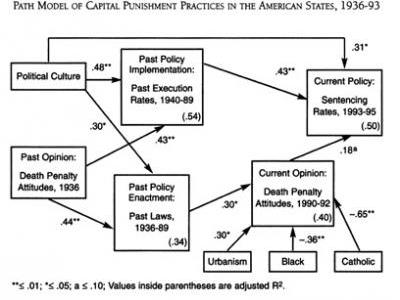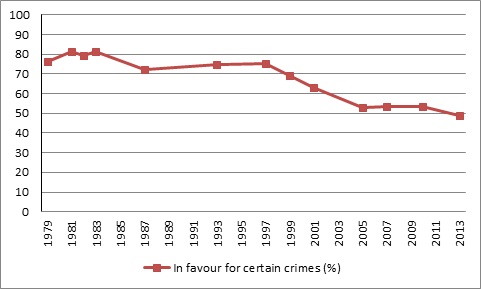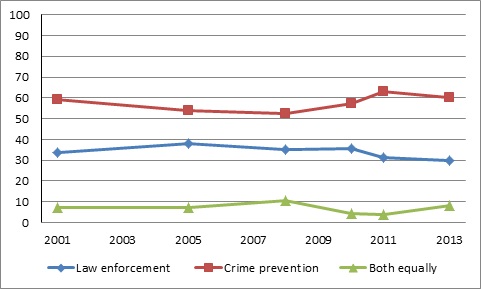Public Opinion and Crime
Public opinion polls have been asking Canadians questions about crime policy, perceptions of crime, and attitudes towards the criminal justice system for over forty years. During this time over 700 questions about crime have been asked by Gallup, Pollara, Ipsos Reid, Statistics Canada’s General Social Survey, the Canadian Election Study and Environics Institute. LISPOP associate Dr. Steve Brown and I have assembled these questions in an archive and are using them to track changes in the public’s views about criminal justice matters over the past few decades.
For more on how public opinion towards crime in Canada has changed over time, please visit lispop.ca. Here, I will focus on how shifts in public opinion towards crime can influence policy.
The relationship between public opinion and policy is complex. In 2000, Barbara Norrander published a study examining capital punishment practices in the United States. Her research shows current death penalty policy in a state is shaped by past policy, political culture and current public opinion. Current opinion is also influenced by past policy and socio economic background. But since past policy is shaped by past opinion there is an indirect effect, where past opinion helps to shape current opinion by changing past policy. Confused yet? Despite the complicated explanation and diagram, below, it’s actually fairly straightforward; past opinion and past policy are constantly influencing one another shaping both current policy and current opinion. Okay, maybe it’s not simple, but it certainly is elegant.

Norrander, 2000 The Multi-Layered Impact of Public Opinion on Capital Punishment Implementation in the United States
This model provides a useful explanation for attitudes towards capital punishment in Canada. Support for capital punishment has been steadily falling since the 1980s. Over 80% of respondents supported capital punishment in the early 1980s, since this time support has fallen significantly. Today when respondents are asked if they support capital punishment for certain crimes support is below 55%.

Support for Capital Punishment
This drop in support can be explained, at least partially, by the abolishment of the death penalty in Canada on July 14th, 1976 (the last execution in Canada took place on December 11th, 1962). Any Canadian, who grew up after this time, grew up in a Canada without the death penalty. So a policy decision, which at the time went against public opinion, helped to shape future public opinion by normalizing a Canada without the death penalty.
Public opinion does not always work this way. Often public opinion will react in the opposite direction of policy decisions. James Stimson a researcher in the United States wrote two books, Tides of Consent and Public Opinion in America, which examine the public mood and compares it to policy decisions. What he found is that public opinion often runs in the opposite direction of the party in power. So if Democrats are in power the people start to say we need more conservative policies and if a Republicans are in power the people start to say we need more liberal policies. Stimson explains that this occurs because of policy excess. A newly elected government starts to implement policies that the public wants, but over time as they continue to create more policies the public starts to say, you’ve gone too far, we need to scale back.
This effect can be seen in Canada. Environics Institute [http://www.environicsinstitute.org/] regularly asks how Canadians would like to see crime addressed, through an emphasis on law enforcement or a focus on crime prevention. Since 2005 there has been a noticeable increase in the number of respondents saying they prefer crime prevention approaches and a decrease in respondents who prefer law enforcement approaches.

Crime Prevention vs. Law Enforcement
Since 2006 the Canadian government has focused on being tough on crime. The policy approach continues to this day but it seems the Canadian public is starting to see these changes as a policy excess. Instead of focusing on punishment, public opinion polls suggest the government focus should be on prevention through education and social development programs.
What do you think? How would you like to see crime addressed in Canada? Do you think we need changes to crime legislation? Would you like to see additional investments in social development programs?
